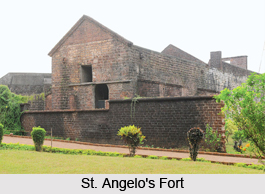 St. Angelo Fort, also known as the Kannur Fort, is one of the important forts of Kerala. The fort serves as a prominent tourist attraction and is located just 3km west from the town of Kannur. It was constructed by the first Portuguese Viceroy, Don Francesco de Almeida in 1505. The fort provides a great view of the Moppila Bay and Dharmadom Island, which are situated near the fort. The Moppila Bay is a natural fishing bay which is also used today. The small island of Dharmadom is spread over an area of five acres and is located just 100 meters away from the coast in the Arabian Sea. St. Angelo Fort faces the Arabian Sea and thus provides an astounding view of the sunrise and sunset.
St. Angelo Fort, also known as the Kannur Fort, is one of the important forts of Kerala. The fort serves as a prominent tourist attraction and is located just 3km west from the town of Kannur. It was constructed by the first Portuguese Viceroy, Don Francesco de Almeida in 1505. The fort provides a great view of the Moppila Bay and Dharmadom Island, which are situated near the fort. The Moppila Bay is a natural fishing bay which is also used today. The small island of Dharmadom is spread over an area of five acres and is located just 100 meters away from the coast in the Arabian Sea. St. Angelo Fort faces the Arabian Sea and thus provides an astounding view of the sunrise and sunset.
History of St. Angelo Fort
St. Angelo Fort has witnessed the rule of many kings and kingdoms. It has a rich historical background and seen many battles fought for the possession of the fort. The fort has constantly remained under attacks after its creation from a number of native rulers in the Siege of Kannur in 1507. However, all their efforts were in vain, as the inhabitants remained under security from different directions. Afonso de Albuquerque had also arrived to confirm himself as the new Governor but Almeida refused to surrender the fort to him. Almeida instead captured Afonso de Albuquerque and imprisoned him inside the Fort.
In the year 1663, the Dutch captured the Kannur Fort from the Portuguese. They constructed bastions Hollandia, Zeelandia and Frieslandia and thus modernized the fort. These bastions serve as a major attraction of St Angelo`s Fort even today. The original Portuguese structure was pulled down later. The Dutch later on sold the fort to a native king Ali Raja of Arakkal, in the year 1772. However, the British seized the Fort in 1790. They renovated the fort and built a military base. They utilized the base as their chief military station in Malabar. Today, St. Angelo Fort or Kannur Fort is a protected monument under the Archaeological Survey of India.
Architecture of St. Angelo Fort
St. Angelo Fort is an exquisite example of architectural design. The fort has been crafted out of laterite. With its massive triangular design and the adjoining bastions, the fort serves as a prominent tourist spot. The protected monument is replete with a big moat which runs around the fort. St. Angelo Fort is an example of Portuguese architecture. However, due to renovations and modernization process the fort appears like a fusion of various European architectural styles. An interesting feature of St. Angelo`s Fort is a wall projecting from the fort that separates the saline sea water of the Arabian Sea from the inland water. The Moppila Bay which has been presently turned into a modern fishing harbour is equipped with modern fishing equipment. This is an Indo-Norwegian Project.
Visiting Information to St. Angelo Fort
St. Angelo Fort is easily accessible through rail, road and air. The nearest railway station is the Kannur Railway Station, which is located 3 km away from the Fort. The nearest airport to St. Angelo Fort is Karipur International Airport, located at Kozhikode, which is 93 km away from the fort.




